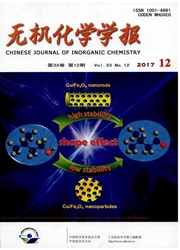

 中文摘要:
中文摘要:
在本工作中,我们以制备纯水相检测的纳米探针为目标,以二氧化硅纳米粒子作为载体,以含特异性检测基团的长发光寿命的磷光铱配合物作为信号单元,通过共价键接枝方法得到几种纳米探针。采用SEM、TEM、SAXRD和氮气吸附等表征方法对纳米探针的表面形貌和内部结构进行表征.并用磷光发射光谱研究基于不同载体所得到的纳米探针的光物理性质以及对高半胱氨酸(Hcy)和半胱氨酸(Cys)的响应性,最后通过理论计算对其响应机理进行探讨。实验结果表明,以MCM-41作为载体的杂化纳米探针具有更强的发光强度和更好的响应性.并且在纯水体系中实现了对半胱氨酸和高半胱氨酸的高选择性检测。
 英文摘要:
英文摘要:
In this work, we designed and fabricated a series of new nanoprobes by using the high specific surface area and good biocompatibility of mesoporous silica nanoparticles as a probe carrier and the long lifetime luminescence of phosphorescent complexes as signal unit. The structures and physical properties of prepared nanoprobes were characterized by SEM, TEM, XRD and nitrogen adsorption/desorption isotherms. Spectrophotometric determination was performed in phosphate buffer saline (PBS) buffer for Hcy/Cys sensing. To further understand the response mechanism, the effect of the aldehyde (CHO) group on the photophysical properties was calculated by using TDDFT calculation method. The result demonstrated that the as-prepared nanoprobe exhibited high selectivity for Hcy and Cys in pure PBS, which provides the advantage in developing excellent phosphorescent cellular probes for practical applications.
 同期刊论文项目
同期刊论文项目
 同项目期刊论文
同项目期刊论文
 Enhancing nonvolatile write-once-read-many-times memory effects with SiO2 nanoparticles sandwiched b
Enhancing nonvolatile write-once-read-many-times memory effects with SiO2 nanoparticles sandwiched b A large perturbation on geometry structures, excited state properties, charge-injection and -transpo
A large perturbation on geometry structures, excited state properties, charge-injection and -transpo Phosphorescent platinum(II) complexes containing different beta-diketonate ligands: synthesis, tunab
Phosphorescent platinum(II) complexes containing different beta-diketonate ligands: synthesis, tunab p-n Metallophosphor based on cationic iridium(III) complex for solid-state light-emitting electroche
p-n Metallophosphor based on cationic iridium(III) complex for solid-state light-emitting electroche Effect of metal centres and substituents on the structure and optoelectronic properties of diaryleth
Effect of metal centres and substituents on the structure and optoelectronic properties of diaryleth Heteronuclear phosphorescent iridium(III) complexes with tunable photophysical and excited-state pro
Heteronuclear phosphorescent iridium(III) complexes with tunable photophysical and excited-state pro Water-soluble phosphorescent iridium(III) complexes as multicolor probes for imaging of homocysteine
Water-soluble phosphorescent iridium(III) complexes as multicolor probes for imaging of homocysteine 期刊信息
期刊信息
